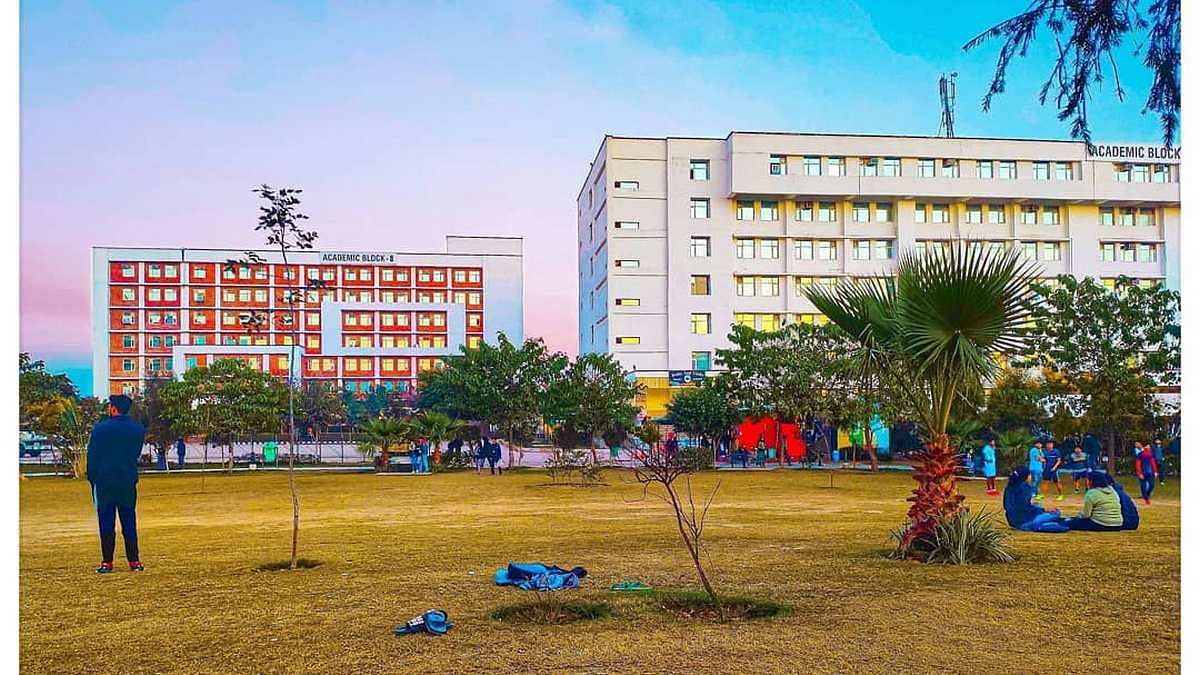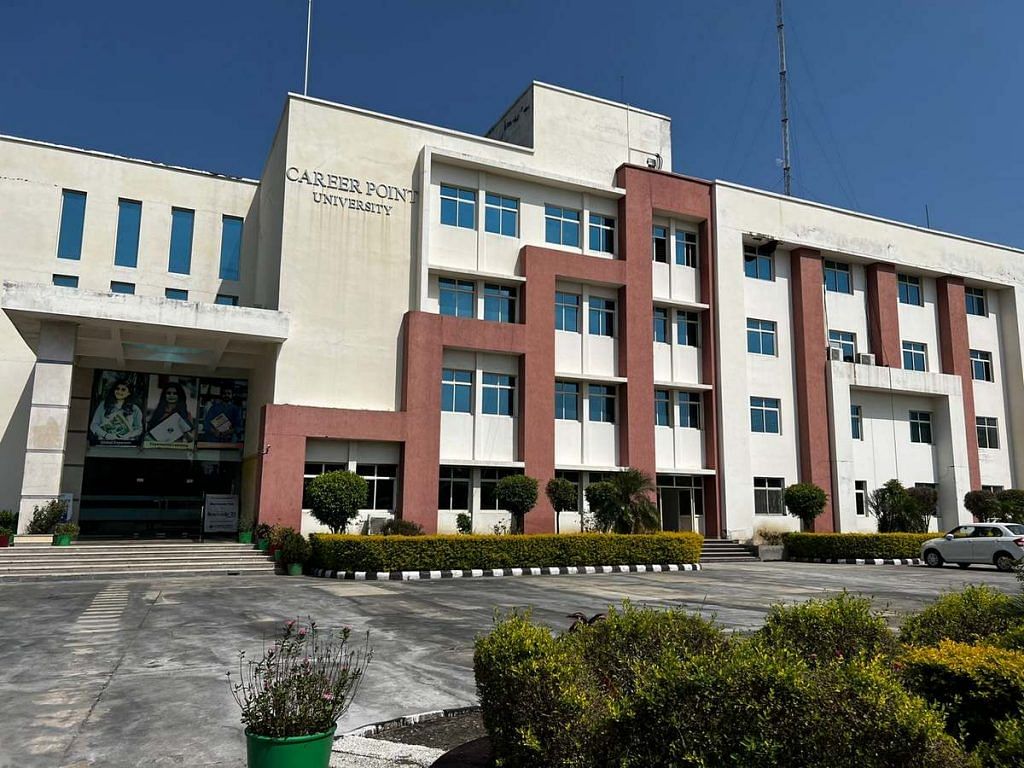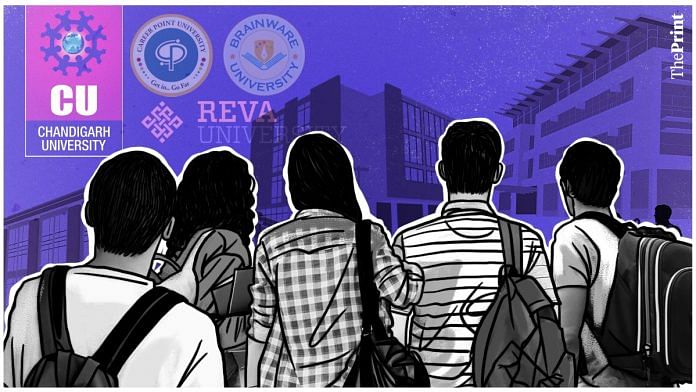New Delhi: Spanking-new buildings, manicured lawns, beaming students, top brand names for placements — these are the standard ingredients in brochures and advertisements for India’s private universities, which have nearly doubled in number over the past seven years.
But visiting these campuses and scratching the glossy surface yields highly variable results, with many students claiming they aren’t always delivered what they were promised despite paying premium fees.
Take for example Chandigarh University, located in Mohali district’s Gharuan village. With its 105-acre grounds, eateries, surveillance cameras, numerous security guards, and imposing buildings that house departments spanning the gamut — from engineering and media studies to management — it claims to be the best university in Punjab.
However, in September, questions about campus security arose in the wake of a major controversy after women students alleged they were being filmed secretly in the hostel washroom. When ThePrint visited the campus last month, several students also voiced concerns about infrastructure and academics, pointing out that they were paying hefty fees and expected a higher standard for both.
Across the country in Bengaluru’s lush REVA University campus and Brainware University in Kolkata, criticism centred on lacklustre placements that did not line up with students’ expectations for the ‘investment’ they had made in their degrees. Students had much the same grouse at Career Point University (CPU) in Kota, where women students also complained about the lack of hostel facilities.
ThePrint reached these universities via phone and emails for a comment on these complaints, but had not received a response at the time of publishing this report.
The issues that students brought up while speaking to ThePrint are not limited to these universities alone.
Even as private universities proliferate and increasing numbers of students sign up, experts say that quality is often an issue despite the high fees charged. The vast majority of these universities also lack accreditation and do not figure in key educational ranking systems.
An explosion in supply and demand
Private or self-financed universities, which are established by Acts of state legislatures, have mushroomed at a tremendous rate over the past few years, nearly doubling from 225 in 2015 to 431 as of August 2022, according to data from the University Grants Commission (UGC), which regulates them. UGC data shows that 68 private universities came up in the last four years.
Altogether, private universities constitute over 30 per cent of the total higher education institutes in India, according to a 2021 study published in the Journal of Higher Education Policy and Leadership Studies.
Authored by Prof Furqan Qamar of Jamia Millia Islamia, this study also used data from the 2007-2020 editions of the central government’s All India Survey on Higher Education (AISHE) to show that while the number of universities — government and private — grew 2.57 times in that period, private universities alone grew 20.44 times.
Demand is also catching up with supply.
While the share of students enrolled in private universities is just about 3.3 per cent of the total enrolment of about 3.85 crore students across institutes of higher learning (including government-run state and central varsities), the numbers show a stark increase.
Just 2.7 lakh students were enrolled in private universities in 2011-12, which went up to 12.76 lakh in 2019-20, shows AISHE data. That’s a whopping 372 per cent rise.
In contrast, enrolment in state public universities grew only 5.35 per cent from 24.47 lakh in 2011-2012 to 25.78 lakh in 2019-20. For central universities — where seats have always been a scarce resource — the numbers registered a 29 per cent increase in the same period, from 5.55 lakh to 7.20 lakh.

Experts believe that students are choosing to go to private universities for numerous reasons, including more competition in public institutions and less rigorous demands in terms of academic cut-offs. In many cases, if you can pay the fee, you’re in.
Speaking to ThePrint, Jamia’s Prof Furqan Qamar, a former secretary-general of the Association of Indian Universities (AIU), also pointed to poor infrastructure in many public institutions.
“Why are people going to private universities? Firstly, the good ones (public universities) are not able to offer as many seats as the demand. Then, the second-rung institutions that are public funded are so underinvested that infrastructure is bad. Living conditions and classroom conditions are so bad they are unable to attract students,” said Qamar.
However, private institutes, most touting themselves as the “best” on offer, do not necessarily provide bang for the buck.
Also read: ‘Need well-rounded professionals’ — why IITs, IIMs & IIITs are giving humanities a new thrust
‘Reality is very different’
The glossy brochure of REVA University in Bengaluru seems to reflect reality accurately enough at first glance with its sprawling campus, lush greenery, and plenty of students, about 17,000 of them — mostly enrolled in science and engineering courses.
But several current and former students that ThePrint spoke to said that there was little “exposure to cultural activities”, and that placements tended to be underwhelming.
“They claim to be the best university and say that 95 per cent of their students are placed but the reality is very different. Most of the students in my batch had to look out for themselves,” said a former student at the university who did not wish to be named.
For the fees students pay — Rs 1.4 lakh per year for engineering courses — they say the placement facilities should be better.
At Kolkata’s Brainware University, it was much the same story. It dubs itself as the “best” private university in Kolkata, but students who spoke to ThePrint said that placements were disappointing last year and they are hoping the situation changes.
ThePrint reached REVA University and the registrar of Brainware University via email, but had not received a response at the time of publishing this report.
Then there is Career Point University (CPU) on the outskirts of Rajasthan’s Kota. Started in 2012 by the Career Point Group, which is best known for its coaching centre of the same name in Kota, the university advertises a plethora of courses and placement opportunities on its website.
However, when ThePrint visited the campus it seemed apparent that the university is essentially an offshoot of the coaching centre and serves as a placeholder for many students who could not crack the Joint Entrance Exam (JEE) for admission to one of the prestigious Indian Institutes of Technology (IITs), or the National Eligibility cum Entrance Test (NEET) for medical colleges.

Many students in Kota enrol for CPU’s BTech or BSc degree programme since they have the option of not attending classes for an entire academic year, except for a month before exams, leaving them ample time to prepare for another shot at the JEE or NEET.
The annual cost for the BTech degree is about Rs 1.30 lakh and for the BSc programme, it’s about Rs 50,000.
Students who spoke to ThePrint said it’s a convenient fallback option, but complained that placements are disheartening. The average engineering placement offers a salary of about Rs 3 lakh per annum.
The facilities, too, leave something to be desired, women students said. There is no hostel for women, which means they must stay as paying guests elsewhere.
ThePrint reached CPU via email and its student counsellors via calls, but no response was received till the time of publishing the copy.
Established in 2012, Chandigarh University is one of the few private universities that made it to the top 200 in this year’s QS Asia University Rankings, published by education research firm Quacquarelli Symonds. It reportedly jumped 90 places to rank at 185 among universities in Asia.
However, here too students had peeves about academics as well as infrastructure.
“Faculty members keep changing very frequently… by the time we adjust to one person, there is a new faculty member in place,” said a second-year engineering student on the campus. Another complaint was that students were not given enough academic guidance after the first year.
Others criticised the campus amenities, including no transport to navigate the vast grounds. “Despite charging huge fees, the institute does not provide basic facilities like shuttle service to students within the campus and AC in classrooms. Shuttle is only limited for guests and parents,” said a biotechnology student.
“We are managing with all the issues because we are hopeful placements will be good,” said another student.
ThePrint reached the university’s vice-chancellor and registrar in person and via email for a comment on these allegations, but they refused to comment and there has been no response to emails.
Students’ complaints apart, more objective data also paints an unflattering picture of the state of private higher education in India.
How do private universities rank?
Only 23 out of more than 400 private universities in India have featured in the government’s National Institutional Ranking Framework (NIRF) since its inception in 2016.
Prof Qamar’s research throws more light on the subject. A 2021 paper, co-authored by him along with Reem Qamar, published in the Journal of Educational Planning and Administration, shows that private institutions lag behind even state public universities in the ranking framework. The ranking uses parameters such as teaching, learning, resources, student strength, peer perception, graduate outcome, and research output.
According to last year’s NIRF list, 70 out of 11,475 government institutions — 0.61 per cent — were ranked in the top 100. However, only 26 out of 32,903 self-financed institutions (which includes colleges, stand-alone institutions and universities) made it to the list — just 0.08 per cent of the total share.
The same paper shows that the largest share — 23.7 per cent — of the NIRF top 100 comprised the IITs and Indian Institutes of Information Technology (IIITs), followed by central varsities (20.83 per cent), and public state universities (4.21 per cent).
In another 2019 paper, published in the Journal of Educational Planning and Administration, Furqan Qamar compared the positions of public and private universities in international ranking frameworks.
According to his research, 1.75 per cent of private universities (six out of 342) featured in the 2019 QS World Rankings in the year 2019, while 3.21 per cent (18 of 562) public universities made the cut. In the Times Higher Education Ranking, the percentage is 3.80 per cent (13 of 342) private, compared to 7.68 per cent (43 out of 560) public universities.
SRM University of Science and Technology, O.P. Jindal University, Amity University, Shoolini University of Biotechnology and Management Sciences are some of the private universities that have featured in QS World Rankings from 2020 to 2023.
Also providing an important data point is the National Assessment and Accreditation Council (NAAC), a government body that evaluates higher education institutes on their quality of education, research, and faculty and grades them from A++ to C. Only 25 private universities have valid NAAC accreditation.
While it’s not mandatory for all institutions to get NAAC accreditation, those that do get a stamp from it are considered quality institutes. The central government has also been laying emphasis on getting more institutions accredited.
‘Path of profitability’
Over the past couple of months, the Supreme Court in two judgments involving private institutions emphasised that ‘profiteering’ is detrimental to education.
Echoing this, Pankaj Mittal, secretary-general of the AIU, said that private universities tend to focus on “the path of profitability” and “ignore the quality of education”.
However, she added that this does not mean that the quality of education is necessarily high in public universities.
“Not just private universities, public universities also have a long way to go in terms of improvement. The private ones aren’t even aided by the government, but still they manage.”
With inputs from Soniya Agrawal, Sandhya Ramesh and Sreyashi Dey
This article has been updated to reflect that UGC data shows 68 private universities came up in the last four years, and not the past year.
(Edited by Asavari Singh)
Also read: Enrolment in online courses up by 179% from last year’s tally, says UGC chairman



